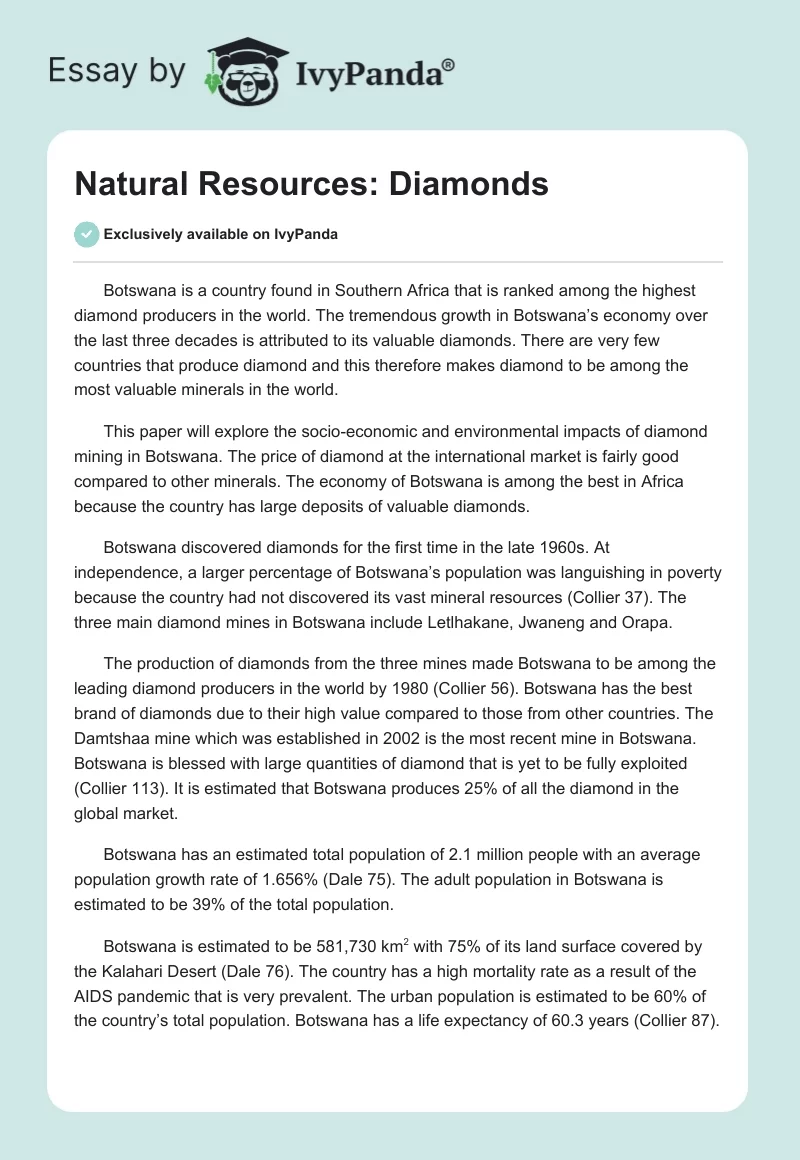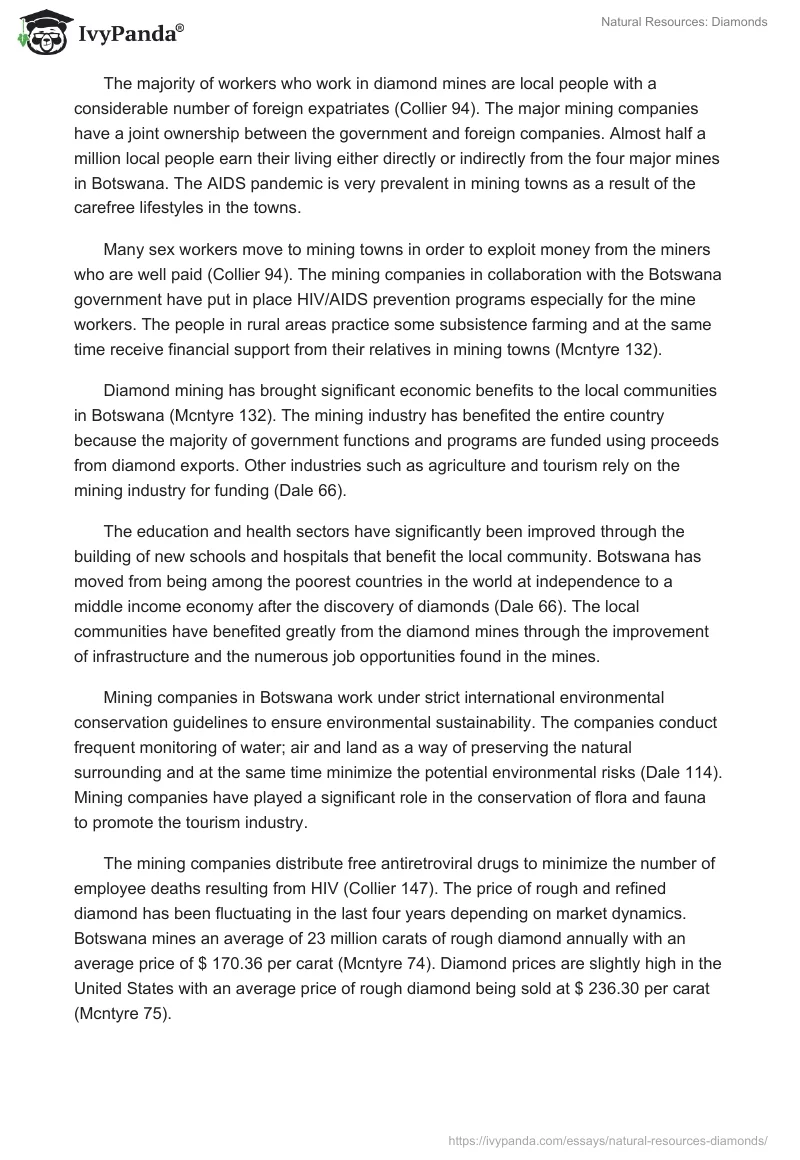Botswana is a country found in Southern Africa that is ranked among the highest diamond producers in the world. The tremendous growth in Botswana’s economy over the last three decades is attributed to its valuable diamonds. There are very few countries that produce diamond and this therefore makes diamond to be among the most valuable minerals in the world.
This paper will explore the socio-economic and environmental impacts of diamond mining in Botswana. The price of diamond at the international market is fairly good compared to other minerals. The economy of Botswana is among the best in Africa because the country has large deposits of valuable diamonds.
Botswana discovered diamonds for the first time in the late 1960s. At independence, a larger percentage of Botswana’s population was languishing in poverty because the country had not discovered its vast mineral resources (Collier 37). The three main diamond mines in Botswana include Letlhakane, Jwaneng and Orapa.
The production of diamonds from the three mines made Botswana to be among the leading diamond producers in the world by 1980 (Collier 56). Botswana has the best brand of diamonds due to their high value compared to those from other countries. The Damtshaa mine which was established in 2002 is the most recent mine in Botswana. Botswana is blessed with large quantities of diamond that is yet to be fully exploited (Collier 113). It is estimated that Botswana produces 25% of all the diamond in the global market.
Botswana has an estimated total population of 2.1 million people with an average population growth rate of 1.656% (Dale 75). The adult population in Botswana is estimated to be 39% of the total population.
Botswana is estimated to be 581,730 km2 with 75% of its land surface covered by the Kalahari Desert (Dale 76). The country has a high mortality rate as a result of the AIDS pandemic that is very prevalent. The urban population is estimated to be 60% of the country’s total population. Botswana has a life expectancy of 60.3 years (Collier 87).
The majority of workers who work in diamond mines are local people with a considerable number of foreign expatriates (Collier 94). The major mining companies have a joint ownership between the government and foreign companies. Almost half a million local people earn their living either directly or indirectly from the four major mines in Botswana. The AIDS pandemic is very prevalent in mining towns as a result of the carefree lifestyles in the towns.
Many sex workers move to mining towns in order to exploit money from the miners who are well paid (Collier 94). The mining companies in collaboration with the Botswana government have put in place HIV/AIDS prevention programs especially for the mine workers. The people in rural areas practice some subsistence farming and at the same time receive financial support from their relatives in mining towns (Mcntyre 132).
Diamond mining has brought significant economic benefits to the local communities in Botswana (Mcntyre 132). The mining industry has benefited the entire country because the majority of government functions and programs are funded using proceeds from diamond exports. Other industries such as agriculture and tourism rely on the mining industry for funding (Dale 66).
The education and health sectors have significantly been improved through the building of new schools and hospitals that benefit the local community. Botswana has moved from being among the poorest countries in the world at independence to a middle income economy after the discovery of diamonds (Dale 66). The local communities have benefited greatly from the diamond mines through the improvement of infrastructure and the numerous job opportunities found in the mines.
Mining companies in Botswana work under strict international environmental conservation guidelines to ensure environmental sustainability. The companies conduct frequent monitoring of water; air and land as a way of preserving the natural surrounding and at the same time minimize the potential environmental risks (Dale 114). Mining companies have played a significant role in the conservation of flora and fauna to promote the tourism industry.
The mining companies distribute free antiretroviral drugs to minimize the number of employee deaths resulting from HIV (Collier 147). The price of rough and refined diamond has been fluctuating in the last four years depending on market dynamics. Botswana mines an average of 23 million carats of rough diamond annually with an average price of $ 170.36 per carat (Mcntyre 74). Diamond prices are slightly high in the United States with an average price of rough diamond being sold at $ 236.30 per carat (Mcntyre 75).
In conclusion, diamond mining is a major economic activity in Botswana that has been instrumental in improving the country’s economy. The mine workers are well remunerated on top of being provided with good working conditions. Safety measures are a priority in all the mines in Botswana and this has reduced the number of accidents that occur in the mines (Collier 156). Australia and the United States record more mine accidents compared to Botswana.
The Government of Botswana in partnership with mining companies offers special services and outreach programs for mine workers with medical conditions. The special initiatives have greatly benefited those workers who are infected or affected by the HIV pandemic (Collier 157). Local production of diamond products should be encouraged to create more jobs for the local people. Despite facing its fair share of challenges, Botswana’s mining industry is a perfect model for other countries to emulate.
Works Cited
Collier, Paul. Breaking the Conflict Trap: Civil War and Development Policy, New York: World Bank Publications, 2003. Print.
Dale, Richard. Botswana’s Search for Autonomy in Southern Africa, New York: Greenwood Publishing Group, 2005. Print.
Mcntyre, Chris. Bradt Botswana: Okavango Delta, Chobe, Northern Kalahari, New York: Bradt Travel Guides, 2010. Print.


